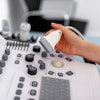
Over the past three decades, more female radiologists have been publishing original research in academic radiology journals, which may indicate that they are finding increased success in their careers, according to a new study in the American Journal of Roentgenology.
Yet there's more to be done to balance the academic field. Even though there's been a consistent upward trend in women's participation in medicine, they continue to be underrepresented in some medical specialties, including diagnostic radiology, wrote researchers from Yale University and the University of Washington.
For example, in 1980, women made up 19.2% of radiology residents; in 2013, they comprised 26.9%. As for the radiology workforce, women constituted 11.5% of academic radiology faculty in 1978, and 28.1% in 2013. These are gains, but they aren't proportional to the number of women in medicine, which the American Medical Association (AMA) estimates to be 57.5%.
 Dr. Crystal Piper from Yale University.
Dr. Crystal Piper from Yale University.Advancement in science and medicine depends heavily on scholarly accomplishments, wrote lead author Dr. Crystal Piper and colleagues. That's why investigating women's contributions to radiology journals can serve as a way to evaluate their professional success, and it could suggest ways of supporting women in the field, particularly through mentoring (AJR, January 2016, Vol. 206:1, pp. 3-7).
"Our aim in this study was to assess trends over time in female authorship in the radiology literature and to investigate the tendency of female first authors to publish with female senior authors," the group wrote. "The results of our study may help the efforts of radiology societies and academic departments increase the representation of women in radiology by elucidating scientific article authorship and mentorship trends."
Where are the women?
The number of women radiologists is low, Piper told AuntMinnie.com. But why?
"One Yale fellow told me that the reason women don't go into radiology is because they like being around children and babies," she said. "I've heard that a lot -- the idea that women just don't do well in technical fields, and that they choose careers that fit the 'lifestyle' of having children. But the reason women aren't choosing radiology is more nuanced than that."
Piper, along with Dr. Howard Forman, also of Yale, and Drs. John Scheel, PhD, and Christoph Lee from the University of Washington, gathered data on the gender of U.S. academic physician authors in Academic Radiology, AJR, and Radiology for the years 1978, 1988, 1998, 2008, and 2013. The group identified the gender of 4,182 of 4,217 authors with medical degrees over the study time frame.
The proportion of original research published by women as the first author increased from 8.3% in 1978 to 32.4% in 2013, while the proportion of original research with women as the senior author increased from 6.8% in 1978 to 22% in 2013. Both of these results were statistically significant.
Piper and colleagues also found that women tend to publish with other women: 23% of female first authors published with female senior authors, compared with 14% of male first authors publishing with female senior authors.
But even though women are contributing more research to the field, the number of female senior authors continues to be low when compared with the overall proportion of women in academic radiology.
"Our findings also inform results of other studies suggesting that male investigators have a greater tendency to conduct research and an increased likelihood of receiving federal grant dollars ... and that women have fewer opportunities for promotion and leadership, which are driven by academic productivity," the group wrote.
More mentorship
Theories about why there are gender discrepancies in radiology include stereotyped gender roles, sexism, and a lack of female mentors. It's this last idea that may hold the most promise for change, according to Piper and colleagues. In fact, mentorship by senior female investigators may be the best way to increase women's career advancement in radiology.
"Encouraging senior female investigators to work with female junior investigators may be one step in addressing the problem that men in the sciences remain better mentored than women," they wrote. "Future studies should track the newer cohort of women who are publishing in radiology as first authors to see whether they become productive senior authors and mentors of other female academic radiologists."
A balanced field in terms of gender is advantageous for everyone, contributing author Lee told AuntMinnie.com.
"Work has been done in the field of gender diversity in medicine and science that shows that gender-diverse research teams have a higher quality of research," he said. "The truth is, our field is more productive when it's more diverse."




















